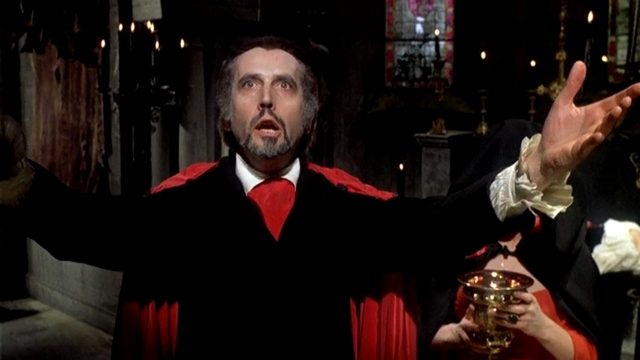Monday Movie: Lust for a Vampire, by Alexander Miller

Every Monday, we’ll highlight a piece of writing from our vaults. This article originally ran as a Home Video Hovel review.
Among the many phases of Hammer, the biggest rift lies in between their period at Bray studios and the later Elstree era. The Bray manor hosted classics like Horror of Dracula, The Curse of Frankenstein, The Mummy and other classics with players like Peter Cushing, Christopher Lee and Oliver Reed. The Elstree days are a mixed bag; some refer to it as the beginning of the end, the “downfall” of the studio. Others love the later days and all the freaky work that emerged. At the end of the day, we have weird comedies like the Bette Davis vehicle The Anniversary and prehistoric adventures and whatever the hell you want to call Moon Zero Two and The Lost Continent. Despite being all over the map, the commitment was still there. Despite the reluctance from Christopher Lee, the Count kept rising from the grave and the wily Baron Frankenstein was up to his old tricks. Hammer’s gold standard set by the early work of Terence Fisher, Val Guest and Freddie Francis began to shift from stately explorations of Victorian Gothic traditions to the more lurid territory, turning up the gore and showing more skin. Nudie vampire flicks with lesbian overtones were the new bread and butter and larger bust sizes were in equal demand alongside the blood and spooky paraphernalia. Leading the charge in Hammer’s later era was the Karnstein trilogy, inspired by Sheridan Le Fanu’s Carmilla, which starts with The Vampire Lovers, concludes with Twins of Evil. Sandwiched right in the middle is Lust for a Vampire. The Karnstein Trilogy isn’t the most substantial work to emerge from Hammer and Lust for a Vampire is the weakest link in a so-so chain.
With its list of faults, Lust for a Vampire falls into the “for fans only” category. The virtues are only seen at the expense of patience-wearing shortcomings to the point where the movie turns into a merit system. The collective reputation of the film is mainly unfavorable and one of the studio’s most compelling cases of a movie that could have been. Looking at the credits, it’s an odd revelation seeing that in-house scribe Jimmy Sangster took the reins as director. And with the gift of hindsight, it’s a little frustrating since studio stalwart Fisher was in line to helm the project.
While his most renowned works are found during the proverbial heyday of Hammer Horror, his later Frankenstein titles, Frankenstein and the Monster from Hell and Frankenstein Must be Destroyed, are proof that he was in tune with the changing frequency, capable of retaining his elevated stylistic province. Since the previous entry, The Vampire Lovers, resulted in decent box-office returns, Hammer put its sequel, Lust for a Vampire, into motion shortly after, putting relative newcomer screenwriter Tudor Gates in the writing chair to concoct a script. The speedy execution can be felt in the screenplay as the film relies on many of the same tropes what worked in favor of The Vampire Lovers. Mystical sexuality, period romanticism and elevated bloodletting worked with the flattering direction of Roy Ward Baker. However, the strain is visible in Lust for a Vampire when the provocative moments feel like gags and the amorous bits are rendered one shade above softcore porn.
Even good actors can save, or at best salvage, a lesser movie and in Hammer’s more minor outings you’d at least get the charm of headliners like Cushing or Lee or character players like Michael Ripper, George Pastell, or Miles Malleson. Ralph Bates headlines here and he’s having a fun time hamming it up, which brings some energy to the screen. But the love story between Richard Lestrange (the thoroughly uninteresting Michael Johnson) and Mircalla (in a relatively charming turn by Yutte Stensgaard) becomes a chore to work through by the film’s midsection. It’s rumored that Peter Cushing was cast, which could have been a game-changer, but his wife’s failing health kept him from appearing in the film.
Lust for a Vampire isn’t entirely a slog. The film has handsome production design, once again a testament to Hammer’s technical chops. The period has some authenticity to it and, despite its structural hiccups, the overall execution is smooth on the eyes. The hazy, soft-focus photography, characteristic of the 1970s, is a nice flourish. It might take some time to get there but the finale features a remarkable staking scene that almost makes the journey worth it.
Despite having been awarded the Queens Award to Industry in 1968, and some financial troubles stemming from American investors pulling out of British cinema, Hammer had a full release schedule in 1971. This full docket would explain the evident wear that emanates from the final product. It seems like Shout!/ScreamFactory are gobbling up as much Hammer as they can and doing the movies justice with these lovingly restored Blu-rays. On VHS, I had nearly written Lust for a Vampire off entirely but this release pumps so much new blood into a familiar movie that it might gather some more admirers.






























